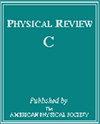先进燃料的激光强化聚变燃烧分数
IF 3.4
2区 物理与天体物理
Q1 Physics and Astronomy
引用次数: 0
摘要
在考虑燃料耗竭的情况下,对激光产生的等离子体中的燃烧分数进行了计算。在 Floquet-Volkoff 框架中分析和计算了强场激光的增强作用,该框架在之前的一项研究中被证实为激光增强聚变截面提供了充分的理论预测[Phys. Rev. C 109, 044605 (2024)]。聚变过程考虑了三种不同的燃料,即氘-氚(DT)聚变、氘-氦聚变和质子-硼聚变。在考虑热分布和非热分布的理想和现实环境中,对它们的激光增强燃烧分数进行了比较。结果发现,在考虑的所有情况下,氘氦核聚变获得的燃烧分数相对增强最小,与前者相比,其余燃料获得的绝对增强不够明显。本文章由计算机程序翻译,如有差异,请以英文原文为准。

Laser-enhanced fusion burn fractions for advanced fuels
Calculations for the burn fraction in a laser-created plasma are presented, taking fuel depletion into account. The enhancement from a strong-field laser is analyzed and calculated in the Floquet-Volkoff framework, which was verified to provide an adequate theoretical prediction for laser-enhanced fusion cross sections in a previous work [Phys. Rev. C 109, 044605 (2024)]. Three different fuels were considered for the fusion process, namely deuterium-tritium (DT) fusion, deuterium-helium fusion, and proton-boron fusion. Their laser-enhanced burn fractions are compared in idealistic and realistic settings, where both thermal and nonthermal distributions are considered. It is found that DT fusion gains the least relative enhancement to the burn fraction in all scenarios considered, and that the remaining fuels do not gain an absolute enhancement large enough to be appreciable in comparison with the former.
求助全文
通过发布文献求助,成功后即可免费获取论文全文。
去求助
来源期刊

Physical Review C
物理-物理:核物理
CiteScore
5.70
自引率
35.50%
发文量
0
审稿时长
1-2 weeks
期刊介绍:
Physical Review C (PRC) is a leading journal in theoretical and experimental nuclear physics, publishing more than two-thirds of the research literature in the field.
PRC covers experimental and theoretical results in all aspects of nuclear physics, including:
Nucleon-nucleon interaction, few-body systems
Nuclear structure
Nuclear reactions
Relativistic nuclear collisions
Hadronic physics and QCD
Electroweak interaction, symmetries
Nuclear astrophysics
 求助内容:
求助内容: 应助结果提醒方式:
应助结果提醒方式:


